Defense & Security
Major military weapons of South Korea defense industry
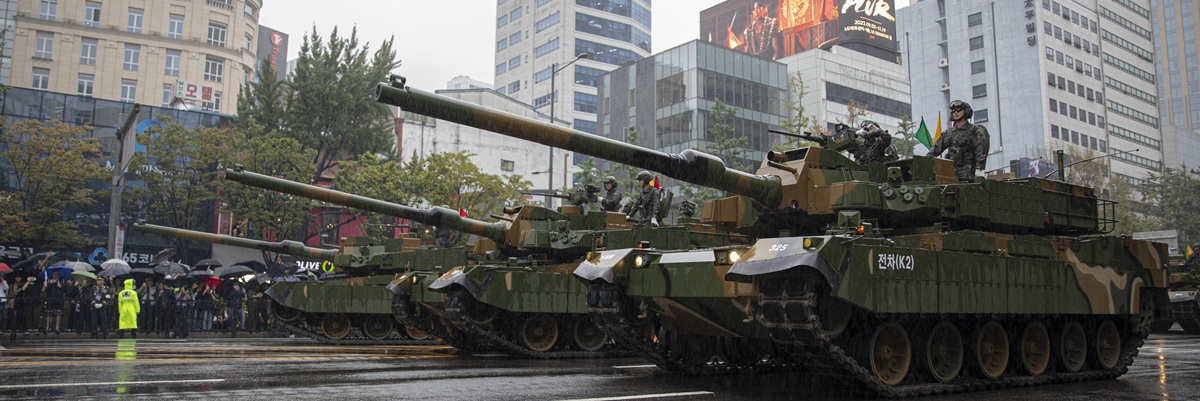
Image Source : Wikimedia Commons
Subscribe to our weekly newsletters for free
If you want to subscribe to World & New World Newsletter, please enter
your e-mail
Defense & Security

Image Source : Wikimedia Commons
First Published in: Oct.07,2025
Oct.07, 2025
South Korea’s defense industry has rapidly emerged as a significant global arms exporter, driven by technological advancements, strategic government support, and increased geopolitical tensions such as the Ukraine war. South Korean arms exports have surged from $1.2 billion (2011–2015) to $38 billion (2021–2023), positioning South Korea as a key player in global arms market, challenging traditional arms exporters. This paper aims to introduce South Korean weapons to government officials and businessmen in European and Middle Eastern countries. This is the first paper in a series on South Korean defense industry. Focus is on South Korean weapons exported to Europe. The second paper will deal with South Korean weapons exported to Middle Eastern countries. This paper first provides an overview of South Korean defense industry and then introduces major Korean weapons exported to European countries.
It was 72 years ago that the bloody 1950-53 Korean War ended with an armistice. Today, South Korea, the once-war-ravaged nation, stands among global leading arms exporters, and its factories turn out advanced tanks, artillery systems and fighter jets destined for battlefields far beyond the Korean Peninsula. As Figure 1 shows, South Korea’s arms industry has been riding a wave of global demand. South Korea’ arms exports increased from 2.5 billion dollars in 2019 to 23 billion dollars (estimate)in 2025. South Korean weapons are in high demand for their advanced technology and fast delivery. As a result, in recent years, South Korea has often been listed among the world’s top 10 arms exporters, competing with the US, Russia and China. As Figure 2, South Korea ranked No. 10 in global arms exports, with a 2.2 % share of the world arms market in the 2020-2024 period, according to the Stockholm International Peace Research Institute. The South Korean government is now setting its sights on breaking into the ranks of global top 4 arms exporters.
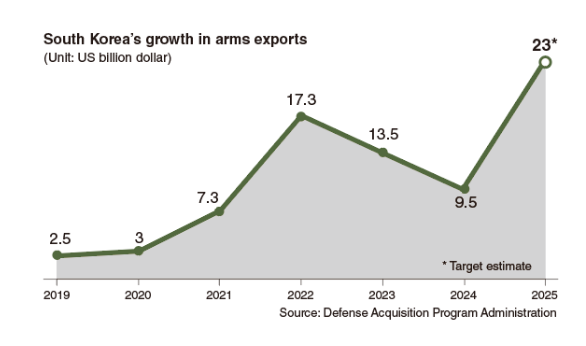
Figure 1: South Korea arms export
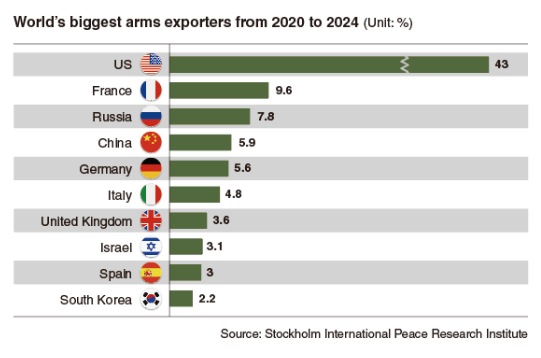
Figure 2: world’s biggest arms exporters
1. Major South Korean defense companies
According to the Defense News Top 100 list for 2020, four of South Korea’s defense companies were ranked in the top 100 defense companies in the world. These four companies are Hanwha (32nd), Korea Aerospace Industries (KAI 55th), LIG Nex1 (68th), and Hyundai Rotem (95th). These South Korea’s top four defense companies are expected to surpass 100 trillion won ($72 billion) in total order backlog in 2025, driven by strong export growth. More European and other countries adopt self-reliant defense strategies as US President Donald Trump warn that the US will no longer protect them for free and as he calls for increasing military spending. Moreover, the Ukraine war and the Gaza conflict continue. Thus, there are higher expectations that South Korea’s leading defense firms will secure more orders. According to data compiled by the Chosun Ilbo, a top Korean newspaper, on May 6, 2025, the combined backlog of South Korea’s top four defense companies stands at around 94.5 trillion won. The figures for Hanwha Aerospace and KAI are based on the results of the first quarter in 2025, while those for LIG Nex1 and Hyundai Rotem reflect data from the end of 2024 (The Chosun Ilbo, May 6, 2025). All four companies secure more export deals, thereby enhancing both the scale and quality of their order books. Hanwha Aerospace, for example, holds 31.4 trillion won in ground defense orders, led by exports of K9 howitzers and Chunmoo multiple rocket systems. Exports account for 65% of that backlog. KAI’s backlog at the end of the first quarter in 2025 reached 24.3 trillion won, up 32% from 18.4 trillion won in 2020. The KAI aims to exceed 29 trillion won by year-end. Its export share has also risen from 50% in 2020 to 63% by the end of 2024. LIG Nex1 holds a backlog of around 20 trillion won as of the end of 2024, while Hyundai Rotem’s stands at 18.8 trillion won. More than half of the orders for both companies come from overseas. Hyundai Rotem is also expected to finalize a second contract with Poland to export around 820 K2 tanks, valued at over 8 trillion won. If finalized, the deal would significantly boost its backlog this year. According to updated data from the Chosun Ilbo, South Korea’s four major defense companies saw their combined order backlog surpass 100 trillion won ($72 billion) for the first time, driven by strong overseas demand. Data in second quarter of 2025 show that Hanwha Aerospace, LIG Nex1, Hyundai Rotem, and Korea Aerospace Industries held backlogs totaling 103.48 trillion won, more than double the 42.23 trillion won recorded at the end of 2021. Industry officials say these companies now have enough work secured for the next four to five years. (The Chosun Ilbo, August 19, 2025)
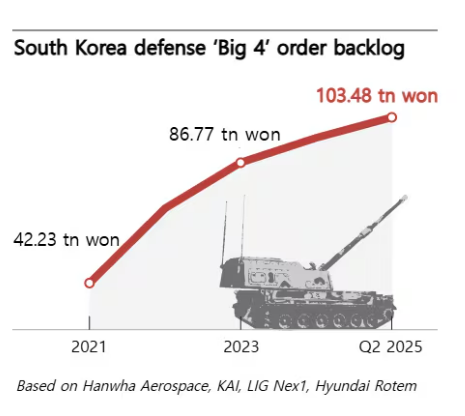
Figure 3: South Korea top 4 defense companies’ order backlog (source: the Chosun Ilbo, August 19, 2025)
This jump in exports of Korean-made conventional weapons has led to the Korean defense industry boom. Orders for Korean artillery weapons and armored vehicles from Eastern Europe and the Middle East have significantly increased since the outbreak of the Ukraine war. Sales of Hyundai Rotem Co., the supplier of the K-2 Black Panther tank, and Hanwha Aerospace Co., the supplier of the K-9 Thunder howitzer, have skyrocketed over the same period. Their parts suppliers have also seen their sales double over a year. The South Korean defense industry’s current heyday is expected to continue for a while as global demand for Korean-made weapons and combat systems has surged amid growing geopolitical conflicts around the world. According to defense industry sources, Hanwha Aerospace is expected to soon close a deal with Vietnam to export the K9 self-propelled howitzers, a contract expected to be worth 1 trillion won. Indeed, Hanwha Aerospace signed an agreement to export its K9 self-propelled howitzers worth US$250 million to Vietnam. Hyundai Rotem is also reportedly nearing the final stage of inking a second agreement with Poland for K2 battle tanks that could be worth over 7 trillion won. LIG Nex1 has supposedly been in talks with Malaysia to export its surface-to-air missile system Cheongung. KAI is looking to export its KF-21 fighter jet to the Middle East. As the Korean defense companies continue to rack up orders and look to expand their list of clients worldwide, JP Morgan released a report on the four major defense firms -- Hanwha Aerospace, Hyundai Rotem, LIG Nex1 and KAI – in March 2025, increasing their stock price targets by an average of 28 percent while pointing out that there is “plenty of room to go” for their values to rise (The Korea Herald, April 17, 2025). The report surprised investors, industry officials and analysts as it set the target prices of the four defense companies higher than the domestic market consensus. J.P. Morgan adjusted the target stock prices of Hanwha Aerospace, Hyundai Rotem, LIG Nex1 and KAI to 950,000 won, 90,000 won, 370,000 won and 120,000 won, respectively. JP Morgan noted that it estimates an annual new order market of 19 trillion won -- 14 trillion won from Europe and 5 trillion won from the Middle East -- for Korean land weapons systems companies. “Korean-made weapons remain one of the top choices for Eastern European countries facing national security issues,” said Lee Tae-hwan, an analyst at Daishin Securities. “Discussions about ordering conventional weapons will gain momentum. The K9 self-propelled howitzers and K2 tanks are excellent candidates with strong potential for scoring additional export deals in Eastern Europe.” (The Korea Herald, April 17, 2025). Yu Ji-hoon, a research fellow at the Korea Institute for Defense Analyses, told The Korea Herald that “South Korea has rapidly matured into one of the world’s leading arms exporters, backed by a highly capable manufacturing base, a track record of delivering on time and at scale, and proven platforms.” (The Korea Herald, April 17, 2025).
According to data from the Korea International Trade Association and the Korea Herald, last year’s biggest importer of Korean defense systems was Poland, which purchased Korea-made weapons worth about $2.51 billion, more than four times what it bought in 2023. The most-exported items were from Hanwha Aerospace, which shipped 212 units of its K9 self-propelled howitzers, and Hyundai Rotem, selling 134 units of the K2 battle tank. (The Korea Herald, April 17, 2025). Middle Eastern countries occupied most of the top five spots among importers of Korean weapons as regional tensions escalated due to the conflicts involving Israel, Hamas, and the Houthis in Yemen. Saudi Arabia ranked second in the purchase of Korean weapons with $530 million in 2024, while the United Arab Emirates and Turkey placed fourth and fifth with $145 million and $113 million, respectively. The United States was the third-biggest importer of Korean weapons at $219 million.
In South Korea’s expanding arms export portfolio, the K2 tank, called “Black Panther” and built by Hyundai Rotem, has been a flagship item. The K2 is South Korea’s most advanced main battle tank, designed for speed, precision and adaptability on the mountainous Korean Peninsula. In recent years, the K2 has drawn major international orders, most notably from Poland, as Polish and other nations’ militaries seek modern armor to replace aging Cold War units. It is central to South Korea’s largest-ever defense export deals, including the one with Poland, signed in 2022, in which Poland ordered 180 K2 Black Panther tanks from Hyundai Rotem in a $3.37 billion agreement. Deliveries began within months, far faster than European or American suppliers could offer. (The Korea Herald, August 14, 2025) In 2025, Poland signed with a $6.5 billion contract for 180 upgraded K2PL tanks, to be produced in part in Poland. The two phases, part of a broader plan involving the manufacturing of up to 1,000 K2s, have made South Korea one of the North Atlantic Treaty Organization’s most important new arms partners and cemented South Korea’s status as a major player in the global defense market. Other key weapons in the South Korean export portfolio are the K239 Chunmoo Multiple Rocket Launcher System, K9 self-propelled howitzer, FA-50 fighter jets and KP-SAM chirons. (The Korea Herald, August 14, 2025) Prominent deals made with global clients include K239 Chunmoo MLRS systems purchased by the United Arab Emirates and Saudi Arabia in 2017 and 2022, respectively. South Korea also signed a $250 million agreement to supply Vietnam with 20 K9 self-propelled howitzers on August 14, 2025, marking the weapon’s first deployment to a member of the Association of Southeast Asian Nations bloc. The K9 howitzers are already in service in countries such as Turkey and Egypt. (The Korea Herald, August 14, 2025) In December 2013, Iraq signed a contract for 24 T-50IQ aircraft, a FA-50 variant, plus additional equipment and pilot training over the next 20 years. The first batch of aircraft was delivered in March 2017. On March 28, 2014, Department of Defense in the Philippines signed a contract for 12 FA-50 fighters worth P18.9 billion (US$421.12 million). Deliveries began in November 2015, all 12 aircraft were delivered by May 31, 2017. (The Korea Herald, August 14, 2025) Indonesian Air Force acquired and operated KP-Sam Chirons since 2014 which was integrated with Oerlikon Skyshield 35 mm anti-aircraft gun system. Additional 2 Chirons transferred according to a 2019 SIPRI small arms report. 54 KP-SAM chirons were delivered to Romania in June 2024.
This is the first paper in a series on South Korean defense industry. Focus is on South Korean weapons exported to Europe. As Table 1 shows, South Korea exported the following weapons to European countries such as Poland, Romania, and Turkey in the period of 2022-2024: K 2 tanks, K 9 howitzer, Chunmoo multiple rocket systems, FA-50, and the KP-SAM Chiron. Table 1: Major defense export contracts, 2022-2024 (source: Issues & Insights on Economy, Technology, and Security, no. 011 (25-06) 4 June, 2025, p. 2)
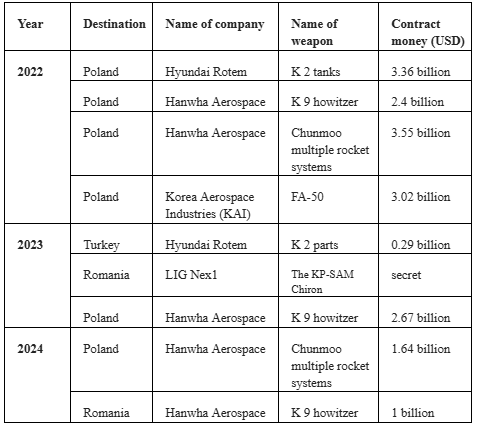
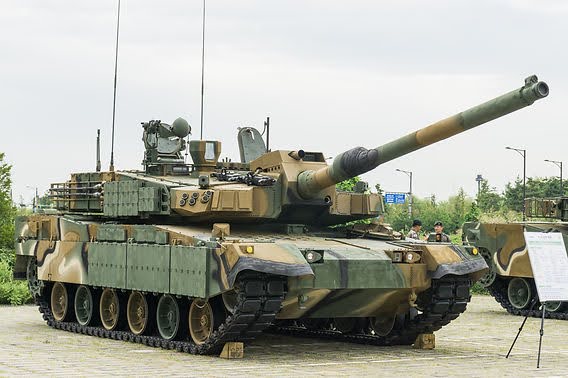

K2 Black Panther (K-2 흑표 tank) is a South Korean fourth-generation main tank, manufactured by Hyundai Rotem. The K2 Black Panther has an advanced fire-control system, in-arm suspension, laser rangefinder, a radar, and crosswind sensor for lock-on targeting. The K2’s thermographic camera tracks target up to 9.8 km, and its millimeter-band radar acts as a Missile Approach Warning System, enhancing situational awareness. And its soft-kill active protection system deploys smoke grenades to counter incoming projectiles. The K2’s autoloader reduces crew size from 4 to 3, thereby providing a faster rate of fire, better fuel efficiency, and lower maintenance costs compared to other western main tanks requiring human loaders. In addition, the K2 can operate in indirect fire mode, offering key advantages over Western designs.[1] The K2’s production started in 2008 and its mass production began in 2013. The first K2 tanks were deployed to South Korean army in July 2014.[2] The K2 Black Panthers were exported to Turkey and Poland. The potential operators of K2 Black Panthers are Armenia, Egypt, Morocco, Peru, Romania, and Slovakia. a. Turkey In June 2007, South Korea and Turkey negotiated a deal worth $540 million that included South Korea’s support for the development of Turkey’s Altay battle tank. On July 29, 2008, Hyundai Rotem and Turkey’s Otokar (Turkish defense firm) signed a contract to provide design assistance and technology transfer for the Altay tank project. This collaboration included systems integration, critical design elements, and manufacturing expertise from South Korea, specifically tailored to develop Turkey’s domestic manufacturing capabilities. South Korea’s contributions to the Altay’s development included the transfer of manufacturing technologies for critical components. Hyundai Rotem played a central role in the system design and integration process, and Hyundai WIA provided the 120 mm 55-caliber smoothbore gun technology. Poongsan Corporation supported the development of ballistic protection systems, while Samyang Comtech shared expertise in advanced armor materials. These collective efforts laid the foundation for Turkey’s capabilities in producing the Altay tank.[3] This cooperation extended beyond technical support, encompassing assistance in establishing production lines for key subsystems. Hyundai Rotem guided Otokar in tank systems development, while MKEK (Turkish mechanical and chemical corporation) received tank gun production technologies. Roketsan (Turkish defense firm) was supported in the design and manufacturing of advanced armor packages. These collaborative efforts were instrumental in the development of prototypes PV1 and PV2, finalized in 2015, and the Altay project's official completion in 2016.[4] On 10 March 2021, BMC, the Turkish contractor responsible for the production of Altay tanks, made a decision to import engines and transmissions from South Korea to address production delays. Seven months later, on 22 October 2021, South Korea’s DAPA approved the export of Hyundai Doosan Infracore (now HD Hyundai Infracore) DV27K engines and SNT Dynamics EST15K transmissions to Turkey. In August 2022, durability testing of the powerpack, combining the DV27K engine and EST15K transmission from South Korea, was successfully completed. Following this success, the first batch of Altay tanks will be produced using this Korean powerpack including engines from HD Hyundai Infracore and transmissions by SNT Dynamics. The tank is in production according to the Turkish media.[5] In 2025, mass production of the Altay tank officially started on 5 September, 2025. b. Poland In January 2020, Poland announced negotiations with Hyundai Rotem for license production of the K2 Black Panther for the Polish Army. On 13 June 2022, the Polish Ministry of Defense announced that it had signed a memorandum of understanding (MOU) to buy at least 180 K2 tanks for the Polish military. On 27 July 2022, the Polish Armaments Group (PGZ) and Hyundai Rotem signed a framework agreement to provide 180 K2s and 820 K2PLs. The contract included rapid arms supply and extensive technology transfer from South Korea. According to the contract, 180 K2s will be produced in South Korea and delivered to Poland starting in 2022, and 820 K2PLs will be produced in Poland under license beginning in 2026.[6] On 26 August 2022, the first executive agreement worth $3.37 billion was signed to procure 180 K2s in Morąg in northern Poland. The contract included logistics packages, training programs, explosive reactive armor packages, 50,000 120 mm, 4.3 million 7.62 mm and 12.7 mm machine gun ammunition for the K2. Soldiers of the 16th Mechanized Division of the Polish Army were sent to South Korea in October 2022 to participate in the training program. The 180 K2 tanks will be delivered during the period of 2022-2025 and then be deployed to the 20th Mechanized Brigade, 15th Mechanized Brigade, and 9th Armored Cavalry Brigade in Poland.[7] On 7 September 2022, PGZ and Hyundai Rotem signed a partnership agreement to develop and produce tanks, armored vehicles and ground unmanned systems. The contract included joint cooperation in building manufacturing facilities in Poland for the production and maintenance of 1000 K2 tanks and the production of K3 next-generation battle tanks. The facilities to be built in Poland will be used as a hub in Europe for the sale and maintenance of Hyundai Rotem’s armed vehicles and tanks. On 5 December 2022, the first 10 K2 tanks arrived in Poland, just “six months” after the signing of the agreement. The tanks were delivered to the 20th Mechanized Brigade of the 16th Mechanized Division on 9 December 2022. On 31 March 2023, the Polish Ministry of Defense signed a foundational agreement with Hyundai Rotem for a consortium to produce K2PL in Poznań.
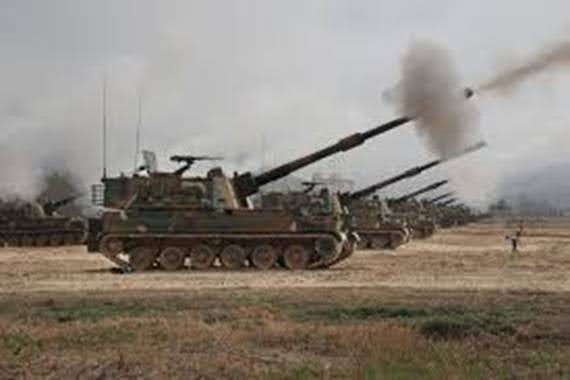

The K9 Thunder is a South Korean 155 mm self-propelled howitzer designed and developed by the Agency for Defense Development and South Korean corporations including Samsung Aerospace Industries, Dongmyeong Heavy Industries, Kia Heavy Industry, and Poongsan Corporation for South Korean Armed Forces. It is now manufactured by Hanwha Aerospace. K9 howitzers operate in groups with the K10 ammunition resupply vehicle variant.[8] The entire K9 fleet operated by South Korean Armed Forces has undergone upgrades to K9A1, and a further upgrade variant K9A2 is now tested for production. As of 2022, the K9 series had a 52% share of global self-propelled howitzer market.[9] The K-9 Thunder is superior to the US self-propelled howitzer M109A6 Paladin or the British self-propelled howitzer AS90. The Chinese PLZ-05 has poor recoil and suspension functions as revealed in the released operating video. And the performance of the Russian 2S35 Kalitsa-SV has not been verified. Compared to the German PzH2000 (currently the world’s best self-propelled howitzer), the K-9 Thunder is a cost-effective alternative, offering a similar balance of performance, range, and mobility but at a lower price, making the K-9 a highly successful export system. The main differences between K-9 and PzH2000 lie in cost and performance. The PzH 2000 has been known for its superior automation and slightly higher firing rate, while the K9 Thunder boasts excellent mobility, a better cost-performance ratio, and seamless integration with its K10 ammunition resupply vehicle.[10] For these reasons, as Table 2 shows, the K9 Thunders were exported to a number of countries such as Turkey, India, Norway, Poland, Finland, Estonia, Australia, Egypt, and Romania.
Table 2: Countries to which K9 howitzers have been exported and the number of units under contract, 2001-2024 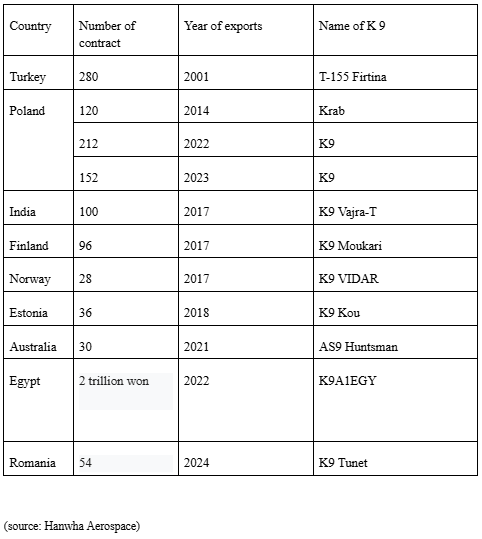
a. Turkey
In May 1999, the Ministry of Defense in South Korea ordered its military attaché in Turkey to arrange a presentation for K9 Thunder. Although Turkey showed interest in K9 Thunder, there was no business deals made as Turkey was planning to produce German Panzerhaubitze 2000 at that time. As Turkey’s plan to build PzH2000 eventually became halted by Germany, South Korea and Turkey signed MOU to strengthen their military and defense cooperation on 18 November 1999.[11]
On 12 December, Turkey sent a team of military general and engineers to Korea to inspect K9 Thunder. Satisfied with the K9’s performance, Turkey cancelled its plan to find replacement from Israel and decided to manufacture K9 Thunder. On 19 February 2000, a technology evaluation team from members of the Agency of Defense Development and Samsung was sent to Turkey and inspected various Turkish companies and facilities including Turkish 1010th Army Factory, MKEK, and Aselsan to optimize manufacturing process of K9 in Turkey. On 4 May 2000, the Ministry of Defense in South Korea and Turkish Land Forces Command signed a memorandum of understanding (MOU) to supply 350 K9 systems untill 2011.[12]
The prototype was finally assembled on 30 December 2000, and earned the nickname Firtina (Fırtına; Storm). Winter test was held in January and February 2001 at Sarıkamış, and Firtina was able to operate in snowy mountain terrain without issue.
A formal contract was signed by Samsung Techwin (formerly Samsung Aerospace Industries) and the Embassy of the Republic of Turkey in Seoul on 20 July 2001. South Korean government promised to transfer the technologies of the Agency for Defense Development to Turkey for free in exchange for Turkey’ purchase of 350 vehicles—280 for Turkish Land Forces and 70 for its future customer—by 2011, which the total is expected to be $1 billion. The first 24 T-155 Firtina consisted of Korean subsystems worth $65 million. The Turkish model was named T-155 Firtina.[13]
Hanwha Defense has generated more than $600 million from Turkey since then, much lower than expected. This is because Turkey produced fewer units than planned and because Turkey increased its localization efforts gradually by indigenous research and from technology transfer.
b. India
On 25 March 2012, South Korean President Lee Myung-bak and the Indian Prime Minister, Manmohan Singh signed Memorandum of Understanding (MOU) to strengthen their economic and military ties. On 29 March 2012 at DEFEXPO, Samsung Techwin and Larsen & Toubro announced their partnership to produce the K9 Thunder in India. According to the agreement, Samsung Techwin will transfer key technologies, and the vehicle will be manufactured under license in India using 50 per cent of the domestic content such as FCS and communication system.[14]
Two units of K9 were sent to Thar Desert, Rajasthan for firing and mobility test, and competed against Russian 2S19. Operated by Indian military personnel, the K9 fired 587 Indian ammunitions including Nub round and drove a total distance of 1,000 km. Maintenance test was conducted at Pune, EMI (electromagnetic interference) test at Chennai, and technical environment test was held in Bengaluru until March 2014. K9 Thunder achieved all ROC set by Indian military while the Russian counterpart failed to do so. Hanwha Techwin (previously Samsung Techwin) later told in an interview that the Russian engine performance dropped when the air density is low and in high temperature, the placement of the engine also resulted in the center of the mass located at the rear, making the vehicle difficult to climb high angles. On the other hand, K9 benefitted from automatic control system of the engine, providing the optimum performance based on given condition automatically—this was one of the decisive reason why India selected K9 over 2S19.[15]
In September 2015, the Indian Ministry of Defense selected Hanwha Techwin and Larsen & Toubro as preferred bidder to supply 100 K9 Vajra-T to the Indian Army after K9 outperformed 2S19 Msta-S and passed two-year trial. On 6 July 2016, India agreed in purchasing 100 K9 Vajra-T for $750 million. On 29 March 2017, the Government of India approved budget of $646 million for purchasing 100 K9 Vajra-T. A formal contract of $310 million was signed between Hanwha Techwin and Larsen & Toubro in New Delhi on 21 April. According to the contract, Hanwha Techwin will supply first 10 K9 Vajra-T, and 90 K9 will be license produced in India by Larsen & Toubro.[16]
In May 2021, it was reported that India’s Defense Research and Development Organisation was working with Larsen & Toubro on a light tank using the K9 chassis with 105 mm or 120 mm gun system to counter China’s Type 15 tank.[17]
The Indian Army planned to order an additional 40 K-9 Vajra-T from Larsen & Toubro as of 2021 after completion of high altitude trials at Ladakh under cold climatic conditions. At that time, India was also looking to export the K9 Vajra-T variant to third countries in collaboration with South Korea and its industry partners.
As per a report in 2022, the Indian MoD could place a repeat order of 200 K9 Vajra-T worth ₹9,600 crore (equivalent to ₹100 billion or US$1.2 billion in 2023) after satisfactory performance of the guns at high altitude terrain.[18]
According to a report in May 2024, the clearance for next 100 units would be approved after the formation of a new government after Indian general election in 2024. The Cabinet Committee on Security cleared the purchase of 100 units on 12 December 2024.[19] The contract, worth ₹7,628.70 crore (US$900 million), was signed with Larsen & Toubro on 20 December 2024 in the South Block, New Delhi. The entire order is to be processed and delivered by the end of 2025. On 3 April 2025, Larsen &Toubro signed another contract with Hanwha Aerospace at $253 million to execute the order.[20]
c. Norway
In May 2015, Samsung Techwin joined the Norwegian artillery upgrade program to replace Norway’s M109Gs with 24 new systems, competing against the KMW Panzerhaubitze 2000, the Nexter CAESAR 6x6, and the RUAG M109 KAWEST. A single K9 was sent to Norway to join the competition. Operated by a sales team, the vehicle went through tests between November 2015 and January 2016. During the January winter test, the K9 was the only vehicle that managed to drive through meter-thick snow field and fire its weapon without any issue. Competing vehicles experienced engine troubles or broken parts.[21]
The K9’s engine was able to maintain heat overnight by simply covering the area with tarpaulin, a simple trick learned from operating experience, allowing the engine to ignite without failure the next day at an extremely cold temperature. The hydropneumatic suspension became a huge advantage for mobility, as its mechanism melted snow on mobility parts much quicker. The test result had also significant impact on Finland and Estonia to acquire K9, because the two nations were invited to observe performances for their artillery replacement.
In December 2017, a contract of $230 million was signed between Hanwha Land Systems and the Norwegian Ministry of Defense. According to the contract, Hanwha would supply 24 K9 Thunder and 6 K10 ARV by 2020. The K9 outperformed competitors in various weather and terrain conditions according to Norwegian military officials during trials.[22]
The Norwegian variant was named K9 VIDAR based on the K9A1 configuration. In November 2022, Norway decided to purchase 4 K9s and 8 K10s, increasing its total vehicles to 28 K9s and 14 K10s (2:1 ratio). The delivery was expected to be completed in 2 years.[23] In April 2025, it was announced that Norway plans to almost double its K9s by ordering an additional 24 K9s for about $534 million USD.[24]
d. Poland
i) PK9 (AHS Krab with PK9 chassis)
In 1999, Poland joined NATO and launched a military program named Regina Project to replace its 152mm Soviet-era SPGs with the NATO standard 155 mm artillery system.
In December 2014, Samsung Techwin signed a cooperation agreement with Huta Stalowa Wola to supply modified K9 Thunder chassis for AHS Krab self-propelled howitzer. The deal is worth $310 million for 120 chassis, which includes related technology transfer and the power pack. From 2015 to 2022, 24 units were scheduled to be manufactured in South Korea, and 96 would be license produced in Poland. First chassis rolled out on 26 June 2015, and all 24 vehicles produced in South Korea were sent to Poland as of October 2016.[25]
Late in May 2022, the Polish government sent 18 AHS Krab howitzers to Ukraine to assist the Ukrainian military to defend against Russia during the Ukraine war. On 29 May, Polish minister of defense visited South Korea for high level talks about the purchase of various Korean weapons to increase AHS Krab production. On June 7, Poland and Ukraine signed a contract for the purchase of an additional 54 units plus support vehicles, in a deal worth US$700 million. The agreement was the largest defense contract that Polish defense industry had made.[26]
On 5 September 2022, Poland ordered 48 Krabs and other support vehicles for a value of PLN 3.8 billion zlotys (USD $797 million).
On 23 December 2024, the contract worth PLN 9 billion for 96 Krabs, command vehicles, command and staff vehicles, ammunition vehicles, and repair workshops was signed. The delivery for this batch was scheduled by the end of 2029.[27]
On 8 April 2025, Huta Stalowa Wola signed a ₩402.6 billion deal with Hanwha Aerospace to supply parts and power packs for 87 AHS Krabs between 2026 and 2028.
ii) K9PL
On 27 July 2022, Polish Armaments Group (PGZ) and Hanwha Defense signed a framework agreement to supply 672 K9PL. Hanwha Defense hoped to expand the deal by adding K10 ARV and K11 FDCV support vehicles. Poland was also expected to produce AHS Krab in parallel; however, due to the low production capability, the deliveries of the existing order will be completed by 2026. On 26 August 2022, an executive contract of $2.4 billion was signed to acquire 212 K9PL manufactured by Hanwha Defense as a Batch I order. Under the contract, Hanwha is responsible for delivery of all 212 vehicles by 30 September 2026. Poland plans to build K9PL locally afterward via technology transfer for the Batch II. On 7 September, Hanwha Defense and WB Electronics signed a $139.5 million deal for installation of Polish communication systems on the Batch I order.[28]
The first 24 K9PL(GF) was rolled out on 19 October 2022. The delivery ceremony was held in Poland on 6 December. The first new K9PL began its construction in July 2023.[29]
On 1 December 2023, Poland and Hanwha Aerospace signed a $2.6 billion agreement for 6 Batch I K9PLs by 2025, 146 Batch II K9PLs between 2026 and 2027, and integrated logistics support for the howitzers and 155 mm ammunitions.[30]
On 4 April 2024, Hanwha Aerospace opened a European office in Warsaw and announced the integration of the K9 and Krab howitzer systems with cooperation from Huta Stalowa Wola to improve the operational and maintenance efficiency of the Polish military.
e. Finland
On 1 June 2016 at KDEC (Korea Defense Equipment & Component) industry fair, South Korea and Finland signed a MOU for defense cooperation including export of used K9. In July 2016, the Finnish Ministry of Defense announced that an undisclosed number of used K9s have been acquired from South Korea. In September 2016, K9 was field tested in Finland, and Seppo Toivonen, the commander of the Finnish Army, visited South Korea to inspect operating units during 2016 DX Korea. On 25 November 2016, two countries signed MOU to supply 48 used K9 for $200 million and match equal amount of free technology transfer related to vehicle maintenance.[31]
On 17 February 2017, the South Korean Ministry of Defense announced that Finland will acquire 48 used K9s over a period of seven years starting in 2018, with conscript training on the equipment begining in 2019. On 2 March 2017, final contract of value of €145 million ($160 million) was signed by two governments in Seoul, South Korea.[32]
On 21 October 2021, Finnish Ministry of Defense authorized exercising option to purchase 10 new vehicles including spare parts and supplies—5 in 2021 and another 5 in 2022—for €30 million, increasing the fleet size to 58 vehicles.[33]
On 18 November 2022 Finnish Minister of Defense Antti Kaikkonen authorized purchase of another 38 used vehicles for €134 million.
The official Finnish designation of the K9 howitzer is 155 PSH K9 FIN, colloquially called Moukari (meaning Sledgehammer).
On 4 March 2024, Millog, a Finnish company, signed a contract with the Finish Defense Force to upgrade 48 vehicles purchased in 2021 and 2022 at €8.1 million. The work is expected to be completed by 2030.[34]
f. Estonia
To reduce the cost for both nations, Finland invited Estonia to jointly procure the K9. In February 2017, Estonian military officials visited South Korea for price negotiations.
In June 2018, Rauno Sirk, the director of the Estonian military procurement agency, announced that Estonia would buy K9 Thunder howitzers. Hanwha Land Systems was to supply 12 used K9s for €46 million, which would cover maintenance, parts and training, as in the contract with Finland. In October 2019, the Estonian Ministry of Defense announced that it would exercise the option to purchase 6 additional K9s under the terms of this contract, at an estimated cost of €20 million.[35]
In August 2021, the Estonian Centre for Defense Investment (RKIK) signed a €4.6 million contract with Hanwha Defense and Go Craft to modernize 24 K9EST Kõu, hinting at purchasing 6 more for its inventory. The upgrade involves communication systems, a FCS, painting, fire suppression system, and electronics.[36]
In September 2022, it was reported that Estonia had purchased 24 vehicles in total. In October, the Estonian defense minister stated that Estonia would procure 12 additional K9s, bringing the total number up to 36 units. In November 2022, Go Craft opened Estonia's first private military workshop, and will start upgrading K9s. In January 2023, Estonia ordered 12 vehicles for €36 million, which will be delivered before 2026. The first Estonian edition by Go Craft was rolled out in February 2023.[37]
g. Australia
In August 2009, it was reported that the consortium of Samsung Techwin and Raytheon Australia had the upper hand for Australia’s Land 17 artillery replacement program by becoming a sole bidder, as KMW, the manufacturer of the competing Panzerhaubitze 2000, had not provided the detailed offering proposal that Australia requested.[38]
The K9 was sent to Australia and was evaluated by the Australian military starting in April 2010. The test included firing M982 Excalibur, a requirement which the K9 satisfied.
In June 2010, the K9 became the preferred bidder for the LAND 17 program, but the program was delayed. In May 2019, in the lead-up to the 2019 Federal Election, the Prime Minister of Australia, Scott Morrison, announced that 30 K9 howitzers and associated support equipment, including ten K10 ammunition resupply vehicles, would be acquired for the Australian Defense Forces. No time frame was given for the purchase.[39]
In September 2020, the Minister for Defense, Linda Reynolds, announced a request for tender to locally build 30 K9s under the Land 8116 Phase 1 Protected Mobility Fires requirement. The sole-source request for tender was released to the preferred supplier, Hanwha Defense Australia, to build and maintain 30 K9s and 15 K10s, as well as their supporting systems. These would be built at Hanwha Defense Australia's Geelong facility. Australian variant AS9 Huntsman was based on Norwegian K9 VIDAR.[40]
In December 2021, the Capability Acquisition and Sustainment Group (CASG) of Australia and Hanwha Defense Australia signed a formal contract of producing 30 AS9s and 15 AS10 AARVs under license at Hanwha Defense Australia facility in Geelong. The estimated value of the deal is $788 million, and manufacturing was expected to start in Q4 2024.[41]
Production of AS9 and AS10 began in June 2023. In July, Australian army conducted tests on ammunition compatibility at the Agency for Defense Development test center in South Korea. In August, another Israeli company Epsilor was selected to supply NATO standard 6T Li-ion batteries for the howitzer.[42]
On 28 March 2024, Hanwha Aerospace announced the beginning of assembly of two AS9s and one AS10 in Changwon. The remaining 28 AS9s and 14 AS10s will be built at H-ACE in Australia.
On 23 August 2024, Hanwha Aerospace invited Korean and Australian government officials for an opening ceremony of H-ACE. The factory will start mass production of AS9 and AS10 in 2024 and deliver all vehicles to the Australian Army by 2027.[43]
In December 2024, Hanwha Aerospace delivered two AS9 and one AS10 to Hanwha Defense Australia, and the Australian military received them in January 2025.
h. Egypt
In 2010, the K9 was evaluated by the Egyptian military to replace its aging artillery fleet. The regional instability resulting from the Arab Spring revolution caused the Egyptian government to postpone the replacing project indefinitely.
In April 2017, it was reported that Hanwha Techwin was again in negotiations with Egypt to export the K9 Thunder. Hanwha Techwin sent a K9 howitzer to Egypt in July and K9 test-fired at a range located west of Cairo in August, competing with the French CAESAR, Russian 2S35 Koalitsiya-SV, and Chinese PLZ-45. During the test, the K9 hit a target ship approaching to the shore, successfully performing an anti-access/area denial simulation against enemy ships for the Egyptian Navy.[44]
In October 2021, South Korea and Egypt discussed the sale of the K9 Thunder. The estimated value of the deal was $2 billion, including training of technicians.[45] In February 2022, South Korea's Defense Acquisition Program Administration (DAPA) announced that Hanwha Defense had signed a $1.6 billion K9 Thunder export contract at Egypt's Artillery House, attended by Egypt's Ministry of National Defense and key officials from both countries. According to the DAPA, the deal provided for the production of 200 K9A1EGY and 100 K10EGY in Egypt, including technology transfer. An unknown number of the earliest vehicles in the series were to be produced in South Korea and delivered to the Egyptian Army and the Egyptian Navy.[46]
The production of the first K9A1EGY was expected in Q4 2022. At a military parade on 25 October 2023, the Egyptian Army unveiled the K9A1EGY in service with the 4th Armored Division. On 1 July 2024, Egyptian media reported that the exact number of South Korean exports was 216 K9A1EGY, 39 K10, and 51 K11. Previously, Egypt received K9A1 and K10 vehicles with 1,000 horsepower Korean-made SMV1000 engines for testing purposes.[47]
On 5 October 2024, Arab Defense reported that the Ministry of Military Production in Egypt announced local manufacturing of the SMV1000 engine by the state-owned Helwan Casting Company, also known as Military Factory 9. In addition, Egypt worked with Hanwha Aerospace in transferring manufacturing technology and installing production lines. The Military 200 became the main manufacturer, and the Military 100 would produce the CN98 cannon and armored steel. Moreover, Egypt plans to become the regional center to export the K9 Thunder system to African and Arab countries, and the Minister of Military Production confirmed negotiations with a number of countries.[48]
i. Romania
On 26 September, 2022, Romanian media reported that the Romanian military was interested in purchasing K9 Thunder and K2 Black Panther. Romania also expressed interest in the K239 Chunmoo multiple rocket launcher and the K21 infantry fighting vehicle. In July 2023, it was reported that Romania planned to acquire 54 (3 systems of 18) K9 Thunders.[49]
On 19 June 2024, Romanian Defense Minister Angel Tîlvăr finally decided to buy 54 K9s worth ₩1.3 trillion ($920 million) during an official meeting with South Korean Defense Minister Shin Won-sik. The Romanian version is called K9 Tunet. The first 18 vehicles are expected to completely built at the Changwon factory in South Korea, while the rest will be assembled in Romania.
On 9 July 2024, Hanwha Aerospace signed the ₩1.3 trillion contract with the Romanian Ministry to supply 54 K9s and 36 K10s, including ammunition and support equipment packages. Hanwha will deliver the vehicle from 2027 in cooperation with a local defense company in Romania. Meanwhile, Hanwha will deliver 18 K9s and 12 K10s from South Korea.[50]
j. Vietnam
The negotiation for K9 Thunder began when Nguyễn Xuân Phúc, the president of Vietnam, visited South Korea for the 30th anniversary of diplomatic ties in 2022.
In March 2023, Vietnam’s highest military figure Phan Văn Giang and other officials showed interests in the K9 by visiting South Korean Army’s K9 operator unit and discussion with Hanwha Aerospace on the potential K9 procurement for the Vietnam military.[51]
In April 2024, it was reported that the Vietnam Ministry of National Defense has officially outlined the K9 procurement plan to its South Korean counterpart, with Korean officials supporting the deal. 108 units was mentioned as the potential purchase number. Vietnam confirmed the purchase on 11 August 2024 during Vietnam Prime Minister Tô Lâm's visit to South Korea.
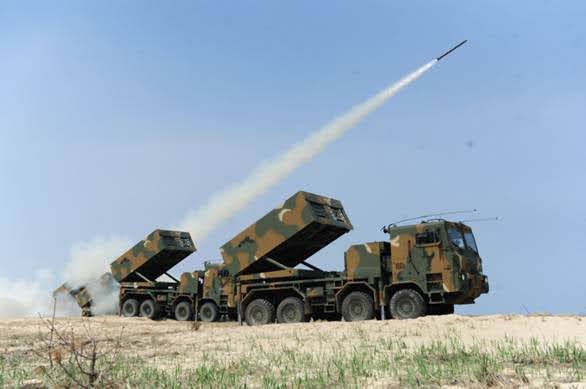

The K239 Chunmoo(천무) is a rocket artillery system developed in 2013 to replace the aging K136 Kooryong(구룡) of the South Korean military. The K239 Chunmoo is a self-propelled multiple launch rocket system (MLRS) capable of firing several different guided or unguided artillery rockets. The Cheonmu has a maximum range of 80km, capable of striking North Korean coastal artillery positions near the Military Demarcation Line and even the Wonsan area. It can fire 12 rounds continuously per minute, striking 12 different targets.[52] The Chunmoo is much better than US military’s HIMARS (High Mobility Artillery Rocket System) multiple rocket launcher in the ammunition capacity. The Chunmoo can fire up to 12 230mm guided missiles in single or burst bursts. Moreover, using 130mm pod-type ammunition (POD) of the same caliber as the Kooryong(구룡), the Chunmoo can fire 20 rounds per pod, for a total of 40 rounds simultaneously. It can also fire the US military’s 227mm MLRS ammunition. The wheeled Chunmoo launcher vehicle boasts excellent mobility, reaching a top speed of 80 km/h. It also has rapid response capabilities, capable of firing its first round within seven minutes of arriving at the firing point, and protection to ensure crew survivability. The Chunmoo boasts an excellent capability of carrying a wide variety of rocket types. The US Hymas, whose effectiveness was recently proven in the Ukraine war, can carry six rockets, while the ATACMS tactical ballistic missile can only carry a single rocket. However, the Chunmoo can fire 130mm rockets (36 rockets per pod), 227mm rockets (6 rockets per pod, two pods), and 230mm rockets (6 rockets per pod, two pods). Unguided 227mm rockets can travel up to 80km, while guided rockets can travel up to 160km, allowing them to strike all major North Korean military targets.[53] The K239 Chunmoo(천무) were exported to United Arab Emirates, Saudi Arabia, and Poland. a. United Arab Emirates (UAE) In 2017, Hanwha Defense announced at ADEX (Aerospace & Defense Exhibition) in Seoul that it had signed a nondisclosure contract worth 700 billion won to export K239 Chunmoo to a certain country in the Middle East. Later it was revealed that the United Arab Emirates signed a supply contract with Hanwha Defense, including 12 K239 Chunmoos, 12 K239T Ammunition Support Vehicles, GPS-guided rockets, and munitions. In February 2021, 12 K239 Chunmoo systems and 12 K239T Ammunition Support Vehicles were delivered to the United Arab Emirates.[54] b. Saudi Arabia At the World Defense Show in Riyadh, Saudi Arabia, on March 9, 2022, Hanwha signed a defense export contract worth 1 trillion won ($800 million) with the Saudi Arabian Ministry of Defense, but details of the contract were not known. It was later confirmed on 31 March 2023 that an unknown number of Chunmoo was in service by the Royal Saudi Land Forces. As in the case of UAE, it is presumed that Saudi Arabia has signed a non-disclosure contract.[55] c. Poland On 27 August 2022, Polish defense minister, Mariusz Błaszczak, said that there were ongoing negotiations to acquire South Korea’s rocket artillery system. On 13 October 2022, Polish Armament Agency announced that the negotiations with South Korea to acquire nearly 300 K239 Chunmoo systems had been completed and the framework agreement was signed on October 17. Poland had originally intended to procure 500 American M142 HIMARS launchers, but such an order could not be fulfilled in a satisfactory timeline, so decision was made to split the HIMARS order into two stages, buying less of them and adding Chunmoo procurement. A supply contract for 288 Chunmoo MLRS mounted on Jelcz 8x8 chassis and equipped with Polish TOPAZ Integrated Combat Management System along with 23 thousand missiles with the range of 80 and 290 kilometers was signed in Poland on October 19, 2022.[56] On 20 August 2023, first Homar-K (Polish version of Chunmoo), which completed system integration and testing in South Korea, was deployed to the 18th Mechanized Division of the Polish Land Forces in Poland.[57]
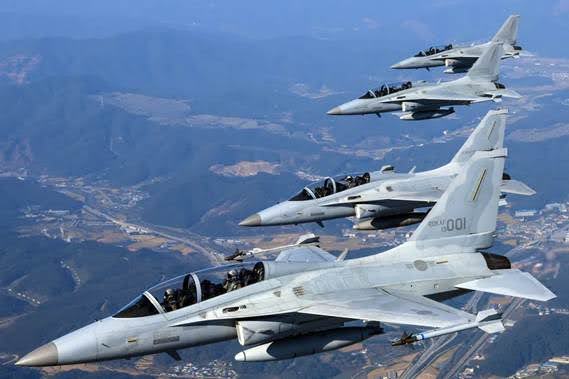
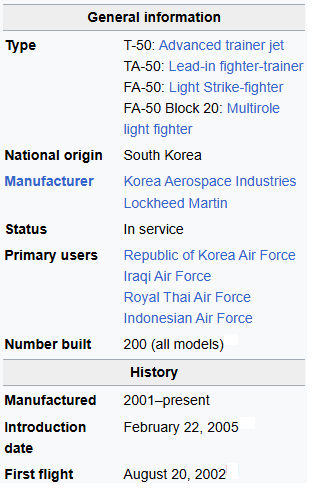
The FA-50 is a light combat aircraft manufactured by Korea Aerospace Industries (KAI) for South Korean Air Force (ROKAF). It is a light combat version of the T-50 Golden Eagle supersonic advanced jet trainer and light attack aircraft. FA-50 aircraft can carry a weapons load of up to 4.5t. The aircraft can be armed with AIM-9 Sidewinder short-range air-to-air missiles, AGM-65 Maverick air-to-ground tactical missiles (AGM), GBU-38/B Joint Direct Attack Munitions (JDAM), CBU-105 Sensor Fused Weapon (SFW), Mk-82 Low Drag General Purpose (LDGP) bombs and Cluster Bomb Units (CBUs).[58] The aircraft is also mounted with an internal, three-barrel 20mm Gatling gun and LAU-3/A 19-tube 2.75″ rocket launcher for firing Folding-Fin Aerial Rockets (FFAR). The wide range of weapon systems aboard the FA-50 jet allows it to counter multiple threats in today’s complex battlefield scenario.[59] The FA-50 platform will be integrated with Lockheed Martin’s Sniper advanced targeting pod (ATP), which is an electro-optical targeting system encased in a single, lightweight pod. It will expand the capabilities of FA-50 with two-color laser spot tracking (LST), high-definition, forward-looking infrared (FLIR), and the Global Scope™ sensor software suite for non-traditional intelligence, surveillance and reconnaissance (NTISR) missions.[60] The FA-50 can be externally fitted with Rafael’s Sky Shield or LIG Nex1’s ALQ-200K ECM pods, Sniper or LITENING targeting pods, and Condor 2 reconnaissance pods to further improve its electronic warfare, reconnaissance, and targeting capabilities. Other armaments include SPICE multifunctional guidance kits, Textron CBU-97/105 Sensor Fuzed Weapon with WCMD tail kits, JDAM, JDAM-ER for more comprehensive air-to-ground operations, and AIM-120 missiles for BVR air-to-air operations. FA-50 has provisions for, but does not yet integrate, Python and Derby missiles, also produced by Rafael, and other anti-ship missiles, stand-off weapons, and sensors to be domestically developed by Korea. The South Korean military is reviewing whether to arm the FA-50 with a smaller version of the Taurus KEPD 350 missile to give it a stand-off engagement capability of 400 km (250 mi). European missile maker MBDA’s Meteor and ASRAAM medium and short-range air-to-air missiles are also reportedly available for integration on the FA-50.[61] Currently FA-50 is operational in South Korea, Indonesia, Iraq, Philippines, Thailand, Poland, and Malaysia. a. South Korea In 2011, the first squadron with the TA-50, the T-50’s light attack variant, became operational with the South Korean Air Forces. In 2014, the FA-50 was officially deployed by the South Korean Air Forces with President Park Geun-hye officially leading a ceremony during which a flight demonstration was held showing its capabilities. 20 FA-50s was assigned its own Air Force wing. 60 FA-50s were ordered by South Korean Air Forces. On October 9, 2014, an FA-50 successfully test fired an AGM-65 Maverick at a stationary target, a retired ship.[62] b. Indonesia Indonesia had been considering the T-50, along with four other aircraft, to replace its BAE Systems Hawk Mk 53 trainer and OV-10 Bronco attack aircraft. In August 2010, Indonesia announced that T-50, Yak-130 and L-159 were the remaining candidates for its requirement for 16 advanced jet trainers. In May 2011, Indonesia signed a US$400 million contract for 16 South Korean T-50s, designated T-50i. They feature weapons pylons and gun modules, enabling light attack capabilities. Deliveries began in September 2013 and the last aircraft were delivered in January 2014.[63] In July 2021, KAI confirmed that it has been awarded a US$240 million contract to supply another batch of six T-50s along with a support and logistics package. c. Iraq Iraq first publicly expressed interest in the T-50 trainers during the Korea–Iraq summit in Seoul on February 24, 2009. In December 2013, Iraq signed a contract for 24 T-50IQ aircraft, a FA-50 variant, plus additional equipment and pilot training over the next 20 years. The first batch of aircraft was delivered in March 2017, while the second batch arrived in May 2018. However, none were flown until June 2022, following the negotiation of a maintenance, logistics and training contract with KAI in November 2021.[64] d. Philippines The Philippine Air Force (PAF) chose 12 TA-50s to fulfill its requirement for a light attack and lead-in fighter trainer aircraft. In January 2013, state media reported that the FA-50 variant, not the TA-50 as previously reported, was selected for procurement. On March 28, 2014, the Department of National Defense in the Philippines signed a contract for 12 FA-50 fighters worth P18.9 billion (US$421.12 million).[65] Deliveries began in November 2015, all 12 aircraft were delivered by May 31, 2017. On January 26, 2017, two PAF FA-50PHs conducted a nighttime attack on terrorist hideouts in Butig, Lanao del Sur in Mindanao, the first combat sorties flown by these aircraft.[66] e. Thailand In September 2015, the Thai government chose Korean T-50TH for its air force over the Chinese Hongdu L-15 to replace its aging L-39 Albatros trainers. In July 2017, the Thai government approved the procurement of eight more aircrafts. Deliveries began in January 2018. The Royal Thai Air Force’s 2024 White Paper outlined a plan to acquire two more T-50TH aircraft in the fiscal year 2025. This acquisition will bring the total number of aircraft in squadron 401 to 16.[67] f. Poland On July 22, 2022, Polish Defense Minister Mariusz Blaszczak announced in a press interview that Poland would purchase 48 FA-50 fighter jets. KAI officially signed a contract with the Polish government on July 28 for 12 FA-50GF (Gap Filler) Block 10 aircraft and 36 FA-50PL (Polish version) Block 20 aircraft.[68] Blaszczak stated that KAI’s ability to quickly deliver aircraft was a decisive factor in the selection. The Russian invasion of Ukraine in 2022 required the Polish Air Force to urgently replace its remaining MiG-29 fighters and Su-22 attack aircraft. However, the United States was unable to supply additional F-16s in such a short timeframe. The FA-50PL contract was awarded for an aircraft version still under development. The FA-50PL is an improved version of the basic FA-50 designed to meet Poland’s specific requirements. Many of these requirements, including the sniper targeting pod, GBU-12 bombs, KGGB guided bombs, and aerial refueling probes, had already been tested and integrated onto the FA-50 platform prior to the Polish order. Other integration plans for the FA-50PL, such as the Phantom Strike AESA radar and Link-16 datalink, were considered challenging, primarily in terms of timing, but not technically impossible.[69] The FA-50PL will be integrated with modern air-to-air missiles such as the AIM-9X Sidewinder and AIM-120 AMRAAM. The FA-50 is a light fighter aircraft similar in size to the F-16. While the FA-50 has limited combat capabilities, it is not without the capabilities and can carry and use certain weapons.[70] The FA-50’s training role has been compared to the Italian M-346 AJT. While the M-346 can simulate a wider range of virtual weapons, it is more expensive to operate than the FA-50. Unlike the M-346, the FA-50 can also be used for training against live targets and has unique combat capabilities. g. Malaysia On February 24, 2023, KAI announced the signing of a $920 million deal with the Malaysian Ministry of Defense for the purchase of 18 FA-50 Block 20 for the Royal Malaysian Air Force’s light combat aircraft (LCA) and fighter in-lead trainer (FLIT) tender, which is intended to replace the Aermacchi MB-339 and Hawk Mk 108/208 currently in service.[71] The FA-50 was in competition with the Indian HAL Tejas, Italian Alenia Aermacchi M-346 Master, Turkish TAI Hürjet, Chinese Hongdu L-15, Russian Mikoyan MiG-35, and Sino-Pakistani JF-17 Thunder. On May 23, 2023, Malaysia signed a $920 million final contract with KAI to purchase 18 FA-50 Block 20s. KAI officials said Malaysia is willing to order 18 more FA-50s later.[72]
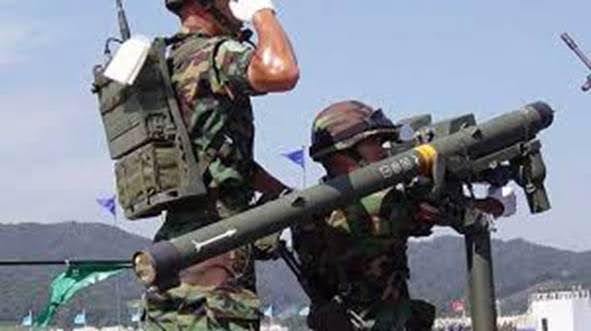
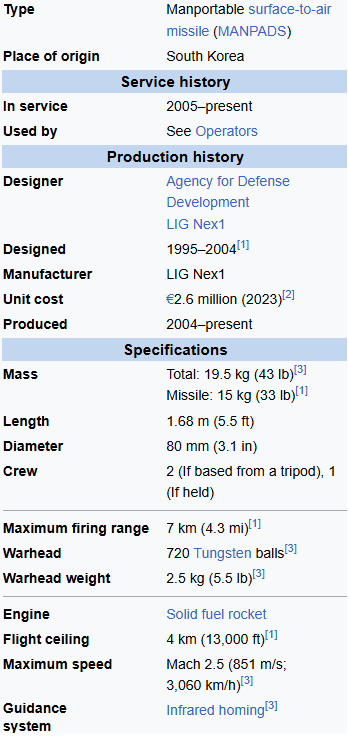
The KP-SAM Chiron (신궁) is a South Korean shoulder-launched surface-to-air missile manufactured by LIG Nex1. The KP-SAM Chiron was created to protect South Korean troops in the forward area, which started in 1995 under the direction of LIG Nex1. The KP-SAM began production in 2004 with extended trials in early 2005.[73] In late 2005, the KP-SAM entered service with the South Korean Army, after development for nearly 8 years. The KP-SAM was marketed in 2012 for India’s modernization of their VSHORAD system, competing with the RBS 70, the Starstreak, the Mistral-2 and the SA-24.[74] In 2014, Indonesia bought the KP-SAM for integration with the Skyshield 35 mm anti-aircraft system.[75] While the KP-SAM missile system externally resembles a French Mistral system, the entire missile systems including the seeker, control section, warhead and motor were developed and manufactured in South Korea. The missile features integrated IFF systems, night and adverse weather capabilities, a two-color (IR/UV) infrared seeker to aid in negating infrared countermeasures (IRCM) and a proximity-fuse warhead. During development tests, the missile scored a 90% hit ratio. According to Agency for Defense Development officials, the KP-SAM is superior to the American FIM-92 Stinger or the French Mistral in hit probability, price and portability. the KP-SAM had been involved in a missile test where its missile made impact on a low-flying target as high as 3.5 kilometers with a speed of 697.5 m/s (more than Mach 2.36) and a distance range of 7 km.[76] The KP-SAM Chirons are operational in South Korea, Indonesia, Romania. Indonesian Air Force acquired and operated Chirons since 2014 which was integrated with Oerlikon Skyshield 35 mm anti-aircraft gun system. Additional 2 Chirons were transferred to Indonesia according to a 2019 SIPRI small arms report.[77] First systems of 54 KP-SAMs were delivered to Romania in June 2024. The KP-SAM Chirons have been operational in South Korean army since 2005.
This paper provided an overview of South Korean defense industry and its major military weapons that have been exported to European countries. The future for South Korean defense industry looks bright because of its advanced technology and fast delivery amid ongoing conflicts in Ukraine and Middle East.
[1] For more information, see "Abrams i Czarna Pantera kontra rosyjskie T-14 i T-90M". Default (in Polish). 2023-01-23. [2] Kim Moon-kyung (27 September 2014). “K2 전차 실전배치 후 첫 공개 -- 백발백중.” YTN. [3] For more detailed information, see Wikipedia https://en.wikipedia.org/wiki/K2_Black_Panther [4] “Altay National Main Battle Tank of Turkey”. Globalsecurity.org. 5 February 2022. [5] Jung Seong-taek (6 February 2015). 파워팩 논란 K2전차 "전력화 이상무"... 1.2km 떨어진 표적지에 '쾅쾅'. The Dong-A Ilbo. [6] Kim Yeon-suk (27 July 2022). 폴란드 "한국에 K2 1천대·FA-50 3개편대·K-9 600문 주문"(종합2보). [7] Shin Jun-myeong (27 August 2022). 폴란드와 K2 전차·K9 자주포 7조6천억 규모 계약 체결. YTN. [8] Kim Minseok (6 March 2022). 8년전 우크라 때리자 꽂혔다...세계최강 K9자주포 진화 이유 [김민석 배틀그라운드]. JoongAng Ilbo. [9] 한화그룹, 대우조선해양 인수로 국내 유일 육·해·공 전문 방산기업으로 '우뚝'. 뉴스투데이, Retrieved 28 September 2022. [10] For information, see https://english.defensearabia.com/dominating-the-battlefield-the-worlds-most-advanced-self-propelled-artillery-systems-2025/ [11] 한-터키 국방장관 방산협력 협의. Yonhap News Agency. 18 November 1999. [12] 국산 K9자주포 첫 수출...터키에 1조3000억 규모. The Dong-A Ilbo. 20 July 2001. [13] "[K9 34회·끝] 터키형 자주포 화력시범 대성공". Kookbang Ilbo. Archived from the original on 8 December 2022. [14] "L&T, Samsung join hands for India's Howitzer artillery". The Economic Times. 29 March 2012. [15] "K9 자주포 & 해외수출 Q&A". Defense Today. 7 May 2020. [16] "K-9 자주포 100문 인도 수출 확정...3500억 규모". Newsis. 21 April 2017. [17] Philip, Snehesh Alex (14 June 2021). "India sets eyes on Russian Sprut light tanks to counter China, gets rare access to trials". The Print. [18] Unnithan, Sandeep (23 January 2022). "What's behind a massive order for Made-in-India howitzers". India Today. [19] "CCS clears Rs 20,000 crore Make in India projects for Su-30 fighter jets, 100 K-9 howitzers - The Economic Times". m.economictimes.com. Retrieved 12 December 2024. [20] "Indian Army accelerates artillery modernisation with indigenous systems". India Today. 13 January 2025. [21] Com, Segye (20 February 2018). 손재일 한화지상방산 대표 "K-9, 해외마케팅 강화. Segye Ilbo. [22] 김귀근 (21 December 2017). 한화, K-9 자주포 24문 노르웨이에 수출 계약...2천452억원 규모(종합). Yonhap News Agency. [23] 박희준 (9 November 2022). 노르웨이, K9 4문·K10 8대 추가 수입...K9 수입량 총 28문. 더팩트 (in Korean). [24] Ruitenberg, Rudy (4 April 2025). "Norway to nearly double its K9 howitzer fleet for around $534 million". Defense News. [25] 한화테크윈, 폴란드에 K9 자주포 96대 수출(종합). Yonhap News Agency. 15 December 2016. [26] "Poland to sell 60 AHS Krab self-propelled howitzers to Ukraine". Ukrinform. 2 June 2022. [27] "한화에어로스페이스, 폴란드에 4000억원대 자주포 부품 공급". Hanwha Aerospace. 8 April 2025. [28] [단독] 한화디펜스, 폴란드 방산업체와 '1920억원 규모' 통신 시스템 공급계약 체결. www.theguru.co.kr (in Korean). 8 September 2022. [29] 한화 김동관 폴란드行...한국선 K9 자주포 조립 개시. Money Today (in Korean). 14 July 2023. [30] MBC경남 NEWS (31 October 2024). [K-방산] K9자주포, K2전차 동시 폴란드 수출 선적 현장 포착..전차 180대 자주포 1차 212문, 2차 152문도 이렇게 납품됩니다. [31] "K-9 자주포, 핀란드 수출 양해각서 체결". Daily NTN. 23 November 2016. [32] "K-9 자주포 핀란드 수출계약 체결, 48문 1.45억 유로 규모". Republic of Korea. 2 March 2017. [33] 박원석 (9 September 2024). 서울대 '2024 한-핀란드 이노베이션 포럼: 떠오르는 민/군 겸용 기술' 개최. Veritas Alpha (in Korean). [34] "Millog sai lisätilauksen Puolustusvoimilta K9-panssarihaupitsien käyttökuntoon saattamisesta". Millog (in Finnish). 4 March 2024. [35] 한화디펜스, 에스토니아에 K9 자주포 6대 추가 수출. Global Economics (in Korean). 25 October 2019. [36] 한화디펜스, 에스토니아 'K9 자주포' 현대화 사업 수주. www.theguru.co.kr (in Korean). 5 August 2021. [37] [단독] 한화에어로, 에스토니아와 'K9 자주포' 12문 추가 계약 ... 3600만 유로. Global Economics [Newdaily] (in Korean). 17 January 2023 [38] "K-9 자주포 호주 수출 유력". Seoul Shinmun. 4 August 2009. [39] Bergmann, Kym (June 2019). "Australian Army to receive massive boost in firepower with 155mm SPH purchase". Asia-Pacific Defence Reporter. 45 (5): 12–16. [40] Kuper, Stephen (2 September 2020). "Government announces request for tender for Army Protected Mobile Fires". Defence Connect. [41] "S. Korea to export 30 units of K-9 howitzer to Australia under W930b deal". The Korea Herald. 13 December 2021. [42] 호주, K9 자주포에 이스라엘산 전력 시스템 장착. 한스경제 (in Korean). 22 August 2023. [43] 강지용 (23 August 2024). 한화에어로스페이스, 호주 방산 생산기지 완공…국내 첫 해외 생산. 파이낸셜포스트 (in Korean). [44] Helou, Agnes (1 February 2022). "Why did Egypt choose to buy South Korea's K9 howitzer?" Defense News. [45] 남수현 (12 October 2021). 박병석, 이집트 대통령 만나 세일즈 외교. JoongAng Ilbo (in Korean). [46] 한화디펜스, 이집트와 K9 자주포 2조원 규모 수출 계약...'역대 최대 규모'. 파이낸셜투데이 (in Korean). 3 February 2022. [47] MBC경남 NEWS (1 July 2024). 국산 파워팩 자주포 탑재 첫 수출. [48] "Egypt produces the advanced Korean K9 Thunder engine locally". Arab Defense. 5 October 2024. [49] “루마니아, 한국의 K9자주포와 K2흑표전차 구매 희망”. Global Economics (in Korean). 27 September 2022. [50] Seo Ji-eun; Lee Hay-june (10 July 2024). "Korea to export K9 howitzers to Romania in nearly $1 billion deal". Korea JoongAng Daily. [51] "Vietnam outlines intent to procure K9 howitzer". Janes.com. Janes Information Services. 24 April 2024. [52] Park Soo-chan (30 May 2021). "사거리 최대 80km ... 축구장 3개 면적 '초토화' [한국의 무기 이야기]". Segye Ilbo. [53] For more information, see Park Soo-chan (22 October 2022) “하이마스보다 낫다” 전면전 공포에 각국, 천무 다연장로켓 '주목' [박수찬의 軍] | 세계일보 https://www.segye.com/newsView/20221021509773 [54] "South-Korean Chunmoo K239 MLRS rockets/missile launcher to enter in service with UAE". Army Recognition. 8 April 2021 [55] "Saudi military unveils Chun-Moo MRLs". Janes Information Services. 4 April 2023 [56] "K239 Chunmoo launchers will increase the deterrence potential of the Polish Army". Defence Industry News. 19 October 2022. [57] Gil So-yeon (20 August 2023). "'K-239 천무' 폴란드 상륙…예정보다 12일 지연". The guru. [58] South Korea plans to arm its FA-50 light combat fighters with new variant of the Taurus missiles, December 8, 2015, at the Wayback Machine – Airrecognition.com, [59] FA-50 Expanded Weapons and Avionics Archived January 12, 2016, at the Wayback Machine. [60] For more information, see https://www.airforce-technology.com/projects/fa-50-light-combat-aircraft-south-korea/ [61] "MBDA To Show New Munitions in Singapore". Archived from the original on February 7, 2018. [62] "The Chosun Ilbo (English Edition): Daily News from Korea – Korea Deploys Home-Grown FA-50 Fighter Jets". Archived from the original on February 8, 2015 [63] Waldron. "Indonesia receives first pair of T-50i advanced jet trainers." Archived December 3, 2013, at the Wayback Machine. [64] Iddon, Paul (June 27, 2022). "Korean T-50 Jets Could Enhance Iraq's Air Campaign Against ISIS". Forbes. [65] "KAI won a contract to export 12 FA-50s to the Phil" (Press release). Korea Aerospace Industries, LTD. (KAI). March 28, 2014. [66] "TV Patrol: DND, kinumpirma ang ugnayan ng ISIS at teroristang grupo sa Pilipinas". ABS-CBN News. January 26, 2017. [67] "Delivery of T-50TH trainer jets to Thailand begins". Seoul. Yonhap News Agency. January 8, 2018. [68] KAI signs US$3 bln deal with Poland to export 48 FA-50s". Yonhap News Agency. July 28, 2022. [69] "Świadoma tego wszystkiego polska strona wciąż parła do stworzenia lepszej wersji FA-50 PL, wpisując na listę życzeń trudne do zrealizowania wymogi.". The Furious Fafik. August 10, 2025. [70] "Korzystając z tego, że już utopiłem 9,90 zł w subskrypcję Onet Premium". The Furious Fafik. August 10, 2025. [71] Waldron, Greg (February 24, 2023). "FA-50 wins Malaysia's light combat aircraft competition". Flight Global. [72] Akhil Kadidal (May 23, 2023). "LIMA 2023: KAI says Malaysia keen to order 18 additional FA-50s". Janes Information Services. [73] Shin In-ho (5 November 2018). "[신궁 1회] 승리의 믿음 K-PSAM 신궁". Defense Media Agency. [74] "VSHORAD – India's Next Big Air Defense Program". April 2012. [75] "Indonesia might buy more Chiron MANPADS systems from South Korea | November 2018 Global Defense Security army news industry | Defense Security global news industry army 2018 | Archive News year". 13 November 2018. [76] "Chiron". www.deagel.com. Retrieved 2015-04-08. [77] For more information, see www.smallarmssurvey.org.
First published in :
World & New World Journal

Unlock articles by signing up or logging in.
Become a member for unrestricted reading!